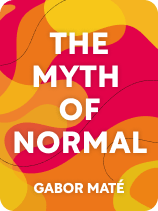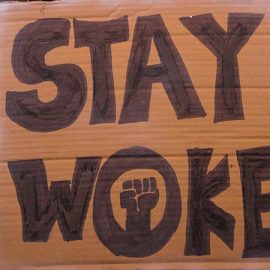

This article is an excerpt from the Shortform book guide to "The Myth of Normal" by Gabor Maté. Shortform has the world's best summaries and analyses of books you should be reading.
Like this article? Sign up for a free trial here.
How do societal norms perpetuate unhealthy standards? Where do “abnormal” behaviors stem from? Are the mind and body one?
In The Myth of Normal, physician and trauma expert Gabor Maté says that there is no such thing as normal when it comes to health and behaviors. Maté argues that the biomedical model fails to understand health holistically.
Here’s why “abnormal” behaviors are actually normal responses to one’s environment.
Rethinking Health and Normalcy
Gabor Maté notes that what we define as “normal” health and behaviors are determined by our social, economic, and cultural systems. Maté believes there is no such thing as normal. In this article, we’ll explore how societal norms perpetuate unhealthy standards, the shortcomings of the conventional biomedical model of health, and how the mind and body can’t be separated when thinking about human health.
Societal Norms Perpetuate Unhealthy Standards
Maté argues that many behaviors labeled as abnormal or pathological are reasonable responses to the conditions and stresses imposed by our society. Society, he writes, values productivity over well-being, material wealth over connections with others, and conformity over individuality. When people can’t or don’t conform to these standards, they experience discomfort, disconnection, and distress. Their behavior is then labeled as “abnormal”—even though what they’re actually exhibiting are natural reactions to unhealthy societal pressures.
For example, a child diagnosed with Attention Deficit Hyperactivity Disorder (ADHD) is conventionally viewed as having a brain disorder that needs to be managed with medication and behavioral therapy. However, the child’s inability to follow classroom rules may be a reasonable response to an education system that requires young people to remain sedentary and suppress their natural energy levels. The “abnormal” behaviors represent a child’s healthy resistance to an overly restrictive model of schooling that’s out of tune with her developmental needs.
| The Link Between Depression and Social Status In Lost Connections, author Johann Hari similarly explores the connection between socially conditioned stress and so-called “abnormal” behavior. He specifically focuses on human depression, writing that it’s a natural stress response we’ve evolved in response to a feeling of low social status. According to Hari, researchers discovered this effect by studying the social hierarchies of baboons. For male baboons in particular, competition for the top spots is brutal. To avoid being ripped apart, low-status baboons make themselves as nonthreatening as possible by lowering and submitting themselves physically to higher-status baboons. Hari writes that this posture and behavior mimics that of severely depressed people. Common life hardships like financial insecurity, lack of control over your daily life, and fractured relationships can inflict as much pain on a person as an alpha baboon inflicts on a weaker male, and can make us feel that we’re “worse” or lower-status than other people. So, we react with the same submission response. |
The Conventional Biomedical Model
Given that many so-called “abnormal” behaviors are actually just responses to societal pressures, Maté goes on to criticize the dominant biomedical model of health for its limited perspective.
Maté argues that the biomedical model fails to understand health holistically, instead viewing health and illness almost exclusively as the result of the physical processes of biochemistry, pathology, and physiology. As such, it doesn’t consider the broader social, psychological, and environmental influencers of health. He writes that this reduces complex human conditions to mere symptoms that need to be treated or managed, often through intrusive and unnecessary pharmaceuticals or surgical procedures.
| The George Brown Study and the Myth of Endogenous Depression In Lost Connections, Hari describes a study that exposed the weaknesses of the biomedical model explored by Maté. In the 1970s, anthropologist George Brown and his team conducted one of the first longitudinal studies looking at the psychological and social predictors of depression. They interviewed hundreds of women (some with diagnosed depression and others with no diagnosis), looking for various factors: severe losses or traumatic events in the previous year, chronic stressors, and “stabilizers,” or positive relationships that counterbalance negative events. The idea was that if depression was truly a brain malfunction, there should be no correlation between life experience and depression. But the results showed a clear distinction between the women with depression and those without it: Only 20% of nondepressed women had experienced a traumatic event in the previous year, compared to 68% of the depressed group. Women with depression were also three times more likely to have chronic stressors in their lives compared to women who weren’t depressed. The study also found that stabilizers had a significant effect on whether the women were depressed: Having a supportive partner and a tight network of close friends was shown to significantly reduce the risk of depression. Today, most psychiatrists agree that endogenous depression—that arising from internal, biological factors rather than external circumstances or life events—is a myth. |
Conventional Medicine’s Paternalistic Model
Maté further critiques conventional medicine for its tendency to place doctors in an elevated position that significantly reduces the agency of patients in their own health and healing process. He warns that this can lead patients to feel disempowered or even invisible—hesitant to voice concerns, question treatment options, or share insights about their bodies and conditions.
| The Ethical Trade-offs of Involuntary Treatment Despite Maté’s concerns about patient empowerment and agency, some medical experts argue that it may sometimes be necessary for doctors to override the wishes of patients when those patients lack the capacity to make informed decisions about their health. In many US states, providing such involuntary treatment requires doctors to obtain permission from the courts. However, while the judicial system does play an important role in preventing paternalistic abuses in medical treatment and safeguarding patients’ rights, medical experts note that judges seldom have the necessary expertise and training to make timely and informed medical decisions on behalf of patients. One proposal to strike the right balance between acting on doctors’ expertise and protecting the privacy rights of vulnerable patients could be to have independent committees of medical providers and ethicists work with patients’ families to expedite decisions in cases where involuntary treatment is being considered. |
Mind and Body Are Interconnected
Maté emphasizes that mind, spirit, and body are interconnected and inseparable at the root of your well-being. This interconnectedness means that your psychological and emotional experiences have direct, tangible effects on your physical health. Thus, chronic stress or unresolved emotional issues can lead to physical ailments, from increased susceptibility to infections and even chronic conditions like heart disease.
| The Historical Roots of the Mind-Body Connection Maté’s idea of an inseparable mind-body connection has deep historical roots. The idea that the mind and body are separate—a theory known as mind-body dualism—is a relatively modern one, often credited to 17th-century philosopher René Descartes. Prior to the popularization of this theory, the general view was that the mind and body were indistinguishable, in accordance with traditional Christian thinking. This view also held that the body had to be intact for a person to go to heaven, meaning dissection of human bodies was taboo. Some experts today advocate for a return to the older mind-body theory, arguing that clinging to the modern mind-body dualism model limits medical science and gives us a fractured view of health that disregards the role of the mind. |

———End of Preview———
Like what you just read? Read the rest of the world's best book summary and analysis of Gabor Maté's "The Myth of Normal" at Shortform.
Here's what you'll find in our full The Myth of Normal summary:
- Why we need to rethink what “normal” means when it comes to mental health
- How certain social conditions instill and reinforce trauma
- The role of trauma in shaping health outcomes






